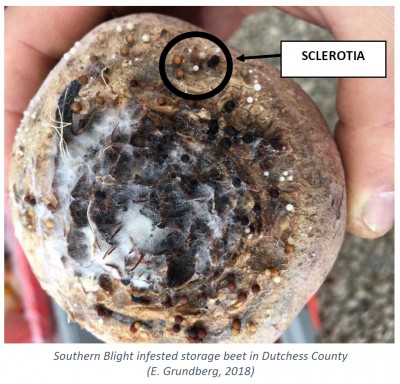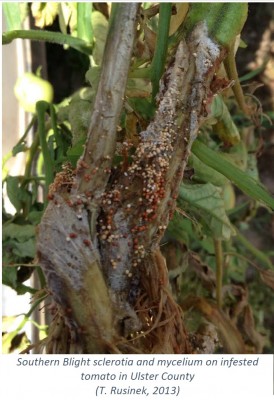Be on the Lookout for Southern Blight
Ethan Grundberg, Vegetable Specialist
Eastern New York Commercial Horticulture
Southern Blight is caused by the fungal pathogen Sclerotium rolfsii and has historically only been a concern to growers in southern states. However, Cornell pathologist Dr. Sarah Pethybridge has seen an
increase in the incidence of Southern Blight in New York over the past several years. This winter, Dr. Pethybridge confirmed the presence of S. rolfsii on golden storage beets in Dutchess County. Given the broad host range of the pathogen that includes over 1,200 crops and weeds, it is imperative that growers who suspect a possible Southern Blight infestation on their farm contact extension to confirm the diagnosis to assist with optimizing crop rotations to reduce soilborne inoculum.
The most common symptom observed in the field is wilting or collapse of the plant. Upon closer inspection, affected plants often have reddish-brown dry lesions at the soil line. Fungal mycelium is also usually present as a thick white mat around the base of the stem. The Southern Blight pathogen also produces overwintering bodies called sclerotia under the right environmental conditions (typically high humidity with temperatures about 80 °F, but sclerotia were found on beets in cold storage at 40 °F). The sclerotia formed by S. rolfsii are a key identifying feature; they are small balls similar in appearance to Dijon mustard seeds that change in color from white to golden to reddish-brown (see image). These sclerotia can survive in the soil for years and endure temperature extremes and drought while waiting to germinate in the presence of a host plant under the right environmental conditions.
Crops that are most commonly affected by Southern Blight are tomatoes, peppers, snap beans, onions, garlic, and Jerusalem artichokes; however, as indicated above, the pathogen can grow and reproduce on a much broader range of plants. Like with most diseases, early detection and proper identification are critical! Infested plants should be removed and destroyed if possible. Symptomatic plants should NOT be placed in compost, as they may contain sclerotia that will then be spread with the compost to other fields. Some small grains and corn are less susceptible to Southern Blight and can be used in rotation in heavily infested fields, but crop rotation is typically not a viable strategy for management of this pathogen given its broad host range. Initial research in New York suggests that deep plowing of infested fields to bury sclerotia and infested residue at least 6-inches deep can lower the pathogen's survival rate.
Several effective chemical controls are available to conventional growers, but they must be applied preventatively. Labeled formulations of azoxystrobin (Quadris), pyraclostrobin (Cabrio), and penthiopyrad (Fontelis) have been effective for growers in the south. Some research has suggested that OMRI-approved biocontrol agents, such as Trichoderma harzianum (RootShield, TerraGrow) and Gliocladium virens (SoilGard), may also help reduce the number of Southern Blight sclerotia and prevent colonization of host plant tissue by the pathogen.



Upcoming Events
How to Obtain a Pesticide Applicator License
December 17, 2025
Thinking about becoming a certified pesticide applicator in New York, but aren't sure where to start? Join DEC representative Kenneth Klubek for a discussion on who needs to become a certified pesticide applicator, certification types, examination procedures, and recertification. Participants will have ample opportunity to ask questions during the program.
Ag Labor Road Show IX
December 1, 2025 : Save the Date! - Ag Labor Roadshow Webinar 1
In addition to the in-person Ag Labor Roadshow program in our region on December 9, two webinars are scheduled for December 1 and December 22. Each webinar will focus on different program content that is different from the in-person sessions. These webinars are an added benefit to program registration.
December 9, 2025 : Save the Date - Ag Labor Road Show In-Person Event (Greenwich, NY)
Greenwich, NY
The Roadshow delivers essential updates on labor law, regulations, and workforce best practices—tailored for farm owners, managers, and ag service providers. Sessions also focus on practical strategies to boost communication, strengthen retention, and build a positive workplace culture.
The in-person session for Eastern NY is December 9 - Elks Lodge, Greenwich, NY - full day in person session
Additional in-person sessions are:
December 10 - Hilton Garden Inn, Watertown, NY, December 17 - Cornell AgriTech, Geneva, NY, December 18 - Genesee Community College, Batavia, NY
December 22, 2025 : Save the Date! - Ag Labor Roadshow Webinar 2
In addition to the in-person Ag Labor Roadshow program in our region on December 9, two webinars are scheduled for December 1 and December 22. Each webinar will focus on different program content that is different from the in-person sessions. These webinars are an added benefit to program registration.
2026 Winter Cut Flower Webinar Series
January 6, 2026 : Session 1: Cut Flower Cost Calculator Updates and Woody Cuts
Session 1: Cut Flower Cost Calculator Updates and Woody Cuts
January 13, 2026 : Session 2: Perennials and Industry Trends
Session 2: Perennials and Industry Trends
January 20, 2026 : Session 3: Anaerobic Soil Disinfestation and Biochar
Session 3: Anaerobic Soil Disinfestation and Biochar
January 27, 2026 : Session 4: Beneficial Insects and Propagation Techniques
Session 4: Beneficial Insects and Propagation Techniques
February 3, 2026 : Session 5: Fungal and Insect Pests and Market Trends
Session 5: Fungal and Insect Pests and Market Trends












































